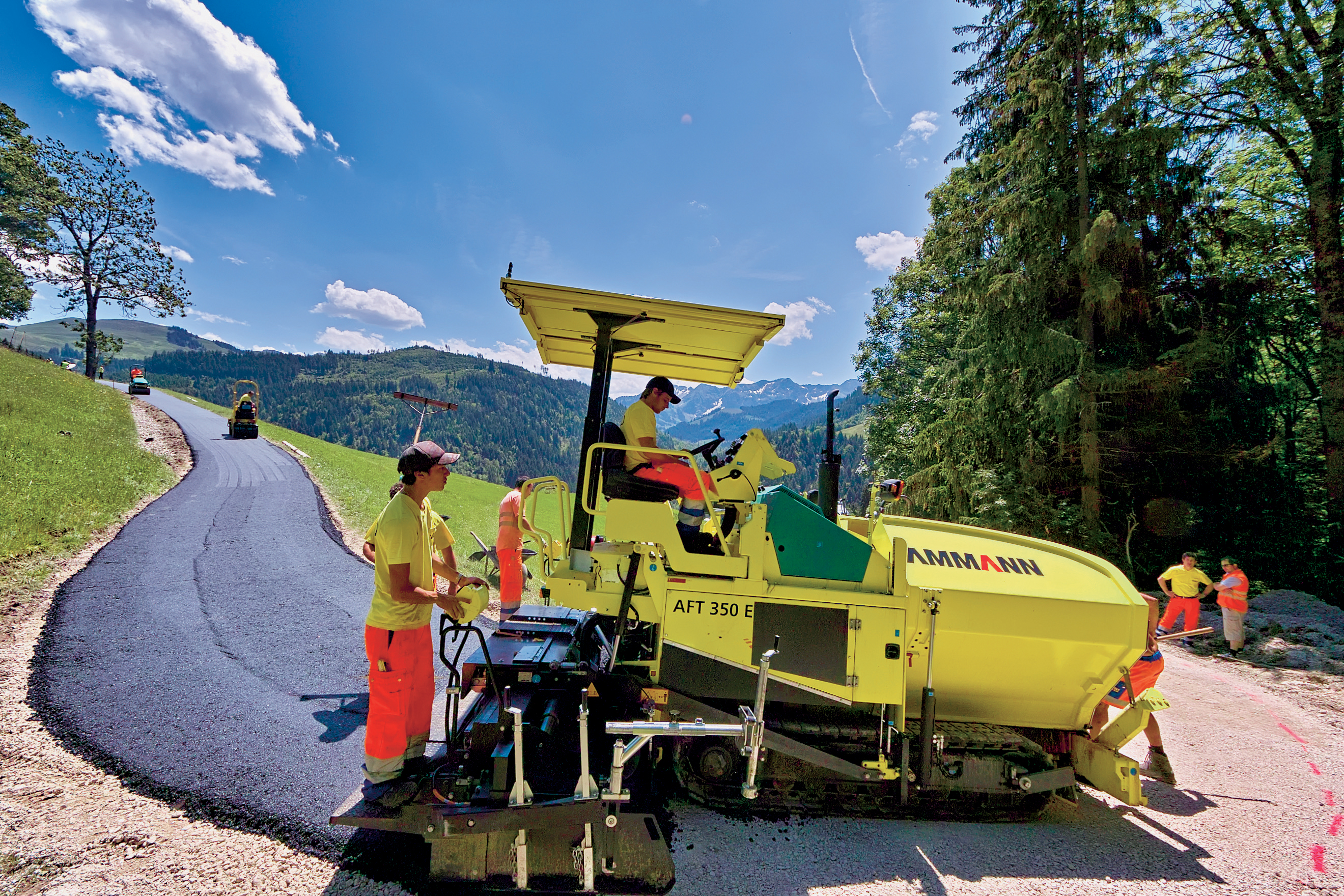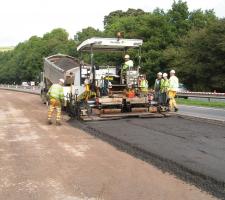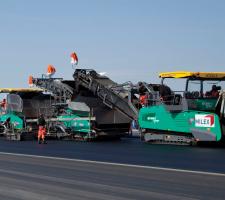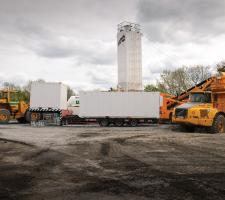
Innovative new technologies are helping reduce road construction costs. Patrick Smith reports
Road construction in many regions of the world has been booming in recent years but it is an expensive business. Indeed, anything to reduce costs and speed up the rate of construction is welcomed by those involved in procuring high quality roads. New technologies and new products are unveiled regularly, but aggregates, virgin or recycled, remain an integral part of construction being used in both asphalt and concrete roads.
In a bid to help its customers,
“The unit has been set up to help contractors, local authorities and network operators cut the cost of new-build road construction projects using cement-bound or recycled asphalt systems,” says the company.
“By offering an alternative option to bitumen-based materials, cement-bound pavements consist of a hydraulically bound mixture used as the base layer which is then surfaced with conventional asphalt.”
Hydraulically bound mixtures describe soil or aggregate mixtures that use binders made from cement, lime, gypsum, granulated blast-furnace slag, air-cooled steel slag and coal fly ash (also known as pulverised fuel ash or PFA). These binders are known as hydraulic as they set and harden in the presence of water.
According to Tarmac, cement-bound roads can be designed to give equivalent service life performance to both conventional asphalt and rigid concrete pavements.
“Removing the need to use high volumes of bitumen can also deliver significant financial savings, given the current price levels,” says the company.
Tarmac Pavement Solutions division will be managed by Richard Vine, National Contracting regional director and, in addition to a range of cementitious solutions, will supply Tarmac’s long-established FoamMaster system, a road surfacing process which uses road arisings in cold-mix production to create an energy-efficient alternative to traditional hot asphalt. It will also supply and lay TarmacDry, a porous asphalt system which manages surface water by allowing it to pass through its structure into a granular reservoir layer.
“With bitumen accounting for around a third of the cost of building a new road, its price volatility means that the sector must embrace cement-bound materials and reduce its reliance on bitumen,” says Vine.
“Driving greater uptake of recycled asphalt is also key to cutting costs and meeting environmental targets and our new service builds upon our extensive expertise in this area.
“We also believe that the durability of cement-bound material provides commercial opportunities in sectors such as ports and aviation.”
Volatile bitumen prices are being driven by a decrease in European refinery production as more of these facilities are converted to produce high-value diesel products.
“The impact of these price hikes on the highways industry has been significant. For road construction, the economic reality is that the sector has to look at alternative and innovative ways of reducing the volumes of bitumen in highways, wherever possible.
“One potential solution to mitigate material costs is to construct new road pavements with cement-bound materials, which are surfaced with a reduced thickness of asphalt.
“The principle of cement-bound or composite roads is not new, but the technology involved is continuing to evolve and improve. Foamed asphalt is another alternative that can also facilitate the reduction in bitumen usage.”
Vine claims that removing the need to use high volumes of bitumen can deliver financial savings on a typical highways infrastructure scheme, potentially in excess of 10% of the construction cost.
“Additional savings can also be realised by recycling in-situ material into the pavement to produce the cement-bound hydraulic base layer, therefore decreasing material cost further.
“Importantly, the financial savings are also made without compromising on quality, safety and durability, making cement-bound materials a good engineering material for major trunk roads and dual carriageways.
“Composite pavements can be designed to give equivalent service life performance to both conventional asphalt and rigid concrete pavements and are now included in the standard design manuals and specifications.”
Earlier this year Bardon Composite Pavements completed a contract which involved mixing and laying a hydraulically bound mixture road sub-base using the newly-launched weighing version of the RMX400C, mobile continuous mixing plant from
By using the mobile plant on site, Bardon (a division of Aggregate Industries) says it was able to keep mobilisation costs to a minimum during the short duration contract.
“The high outputs, achievable through the mixing plant, enabled the works to be completed in seven days, which was ahead of the contractor’s programme,” says John Donegan, technical director of Bardon Composite Pavements.
The contract on the 3km long Longford Bypass in Ireland involved mixing and laying HBM road sub-base, which was a CBGM C16/20, with local aggregates. The scheme was carried out for Ireland’s National Roads Authority by civil engineering contractors Wills Bros.
The Rapid International plant can produce up to 400tonnes/hour and records the quantities by weight of each material added. Its record keeping is automated, precise and detailed and provided Bardon with accurate information.
The new RMC400CW model now incorporates a 1,200mm belt conveyor between the aggregate hopper and the continuous mixer. The weighing belt is supported on load cells and this measures the weight, allowing the feed rate of the aggregate to be determined. The new plant also incorporates a cement weigh system, using a rotary valve feeding a weighed screw with twin outlets for discharging into the mixer. The water is monitored using a flow meter.
In the Swiss mountains two road construction projects incorporating low-temperature asphalt were successfully implemented as joint projects carried out by engineering company Keller Ingenieure; the asphalt mixing plant Berag Rubigen and construction company Walo Bertschinger.
Old gravel access roads to the farms of Andreas Kilcher and Christian Zbinden, which are costly and high maintenance, were replaced by two asphalt roads using an environmentally friendly blacktop on the basis of Ammann Foam.
The ACT 22 L blacktop with foamed bitumen is produced at a temperature of around just 115 °C and can be laid at even lower temperatures, says Ammann.
“A normal bitumen of type B160/220 was foamed at the Universal S asphalt mixing plant in Rubigen. The process produced around 750kg fewer CO2 emissions thanks to the drop in temperature alone.” The blacktop was also made using around 50% reclaimed asphalt.
“The blacktop composition matched the specifications exactly. This was made possible by modern plant technology and the Ammann as1 control software,” says Ammann.
Some 150tonnes of blacktop was installed on each farm, equivalent to 2,000m² “with not a trace of emissions on site thanks to the low installation temperature.”
Andreas Biedermann, expert for low-temperature asphalt at Ammann, says: “If we can also use more reclaimed asphalt in conjunction with low-temperature asphalt and lower the temperature during production and installation then all the better.
“Access roads like these are subject to a lot of strain. The farmers usually drive their machines along the same tracks. This results in depressions similar to those on highways that cause [problems such as] aquaplaning. This is another aspect where blacktops for access roads need to demonstrate a certain stability.”
Stefan Lack, construction team leader at Walo Bertschinger, says: “Our production analyses show no differences to hot asphalt with regard to compaction, porosity, lifetime and smoothness. Both are equally as good and comparable.
“I am convinced that foamed bitumen is the right way ahead and a good path to follow because it saves energy. One should not forget that the mix is 30–40°C cooler than a hot asphalt mix. And these 30–40° are pure oil that otherwise needs to be combusted.”
Road construction with compact asphalt pavements built hot-on-hot by two pavers working one behind the other was officially recognised as a standard method when General Circular ARS No. 2/2012 was issued by the German Federal Ministry of Transport in 2012.
Prompted by the method’s inclusion in the German catalogue of standard construction methods, the German Road and Transportation Research Association (FGSV) organised a colloquium devoted to the subject where speakers from administration and the construction industry reported on their experience in construction and rehabilitation projects.
“The advantages of compact asphalt pavements in general and
An InLine Pave train comprises a material feeder and two pavers. The feeder’s long conveyor alternately supplies the two pavers with material while the “most important part of the train is the SUPER 2100-2 IP paver with AB 600 high compaction screed in TP Plus version.”
A standard paver with minor modifications, it is equipped with a special transfer module to transport the asphalt to the second paver in the InLine Pave train. The surface course is placed on the highly compacted binder course by a SUPER 1800-2 or SUPER 1600-2 paver with standard AB 500 TV extending screed following directly behind it.
“Since all three machines undergo only marginal modification for the InLine Pave process, they can also be used for conventional projects,” says Vögele.
“Compact asphalt pavements mean a leap in quality: rutting is effectively eliminated,” says Dittmar Marquordt from the road construction authority of Saxony-Anhalt, a region well over 1 million m² of compact asphalt pavement has been constructed.















